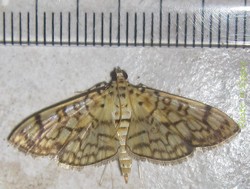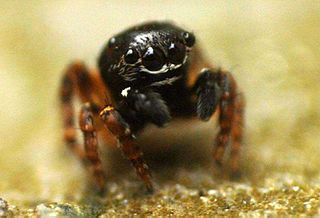
Latrodectus is a broadly distributed genus of spiders with several species that, together, are referred to as true widows. This group is composed of those often loosely called black widow spiders, brown widow spiders, and similar spiders. However, such general "common names" are of limited use as the diversity of species is much greater. A member of the family Theridiidae, this genus contains 32 species, which include several North American "black widows". In addition to these in North America are also the red widow Latrodectus bishopi and the brown widow Latrodectus geometricus, which, in addition to North America, has a much wider geographic distribution. Elsewhere, others include the European black widow, the Australian redback black widow, several different species in Southern Africa that can be called Button spiders, and the South American black widow spiders. Species vary widely in size. In most cases, the females are dark-coloured, but some may have lighter bodies or even reddish. Many can have red, white or brown markings on the upper-side (dorsal) of the abdomen. Some can be readily identifiable by reddish markings on the central underside (ventral) abdomen, which are often hourglass-shaped.

Nursery web spiders (Pisauridae) is a family of araneomorph spiders first described by Eugène Simon in 1890. They resemble wolf spiders (Lycosidae) except for several key differences. Wolf spiders have two very prominent eyes in addition to the other six, while a nursery web spider's eyes are all about the same size. Additionally, female nursery web spiders carry their egg sacs with their jaws and pedipalps instead of attaching them to their spinnerets as wolf spiders do. When the eggs are about to hatch, a female spider builds a nursery "tent", places her egg sac inside, and stands guard outside, hence the family's common name. Like the wolf spiders, however, the nursery web spiders are roaming hunters that don't use webs for catching prey.

Crevice weaver spiders (Filistatidae) comprise cribellate spiders with features that have been regarded as "primitive" for araneomorph spiders. They are weavers of funnel or tube webs. The family contains 18 genera and more than 120 described species worldwide.
In Greek mythology, Poltys is a mythical king and eponym of the Thracian city of Poltyobria, featured in Apollodorus's account of the story of the hero Heracles. Poltys and his brother Sarpedon are given as sons of the sea-god Poseidon.

The American Elm cultivar Ulmus americana 'Columnaris' was propagated from a tree found by Mr John Dunbar at Conesus Lake, New York, before 1920. The tree should not be confused with U. americana var. columnarisRehder,J. Arnold Arbor. 3: 42, 1922.

Banksia columnaris is a species of column-like shrub that is endemic to Western Australia. It has pinnatifid leaves with between five and eighteen lobes on each side, heads of pale yellow to purple flowers and usually only one or two follicles forming in each head.

Flavobacterium columnare is a thin Gram-negative rod bacterium of the genus Flavobacterium. The name derives from the way in which the organism grows in rhizoid columnar formations.

Gasteracantha cancriformis is a species of orb-weaver spider. It is widely distributed in the New World.

Araucaria columnaris, the coral reef araucaria, Cook pine, New Caledonia pine, Cook araucaria, or columnar araucaria, is a species of conifer in the family Araucariaceae.
P. monstrosus may refer to:

Haritalodes derogata, the cotton leaf roller or bhindi leaf roller, is a species of moth of the family Crambidae. It was described by Johan Christian Fabricius in 1775. It is widely distributed. Records include the Comoros, the Democratic Republic of the Congo, Ghana, Mali, Réunion, Madagascar, the Seychelles, South Africa, the Gambia, Australia, Fiji, Papua New Guinea, Samoa, the Solomon Islands, the Andaman Islands, Bali, India, Sri Lanka, Malaysia, Myanmar, Singapore, Sri Lanka, Vietnam, China and Japan. It is sometimes encountered in Europe, due to accidental import.

Cyrtophora unicolor is a species of spider of the genus Cyrtophora. It is known as the red tent spider.
Sipalolasma ellioti is a species of spider of the genus Sipalolasma. It is endemic to Sri Lanka. The female is 11 mm in length.
Sipalolasma greeni is a species of spider of the genus Sipalolasma. It is endemic to Sri Lanka. The carapace and legs are deep brown in color. The abdomen is black. The known length is about 22 mm. The species was first found from Punduloya, Sri Lanka.

Poltys is a genus of orb-weaver spiders first described by C. L. Koch in 1843. Many species are cryptic and are known to masquerade as leaves and twigs during the day, and build an orb web at night to capture prey. The shape of the abdomen which often gives the impression of a rough and broken branch can vary among individuals within a species. The web is eaten up before dawn and reconstructed after dusk.
Hermippus is a genus of ant eating spiders in the family Zodariidae, containing twelve species restricted to Asia and parts of Africa. Three new species were discovered in 2014.

Phanuelus is a spider genus of the jumping spider family, Salticidae. The single described species Phanuelus gladstone is endemic to India. The holotype and paratypes of P. gladstone were all collected from the campus of Madras Christian College in Chennai. Adult spiders are 3–4 mm in length with a short, high carapace and rounded abdomen.
Pandanus columnaris is a dioecious tropical plant in the screwpine genus. It is endemic to Madagascar. The specific epithet, "columnaris", refers to the columnar shape of the crown of the tree. Originally described by S. John as separate species, Pandanus columnaris is now considered a synonym for Pandanus pluriloculatus.













